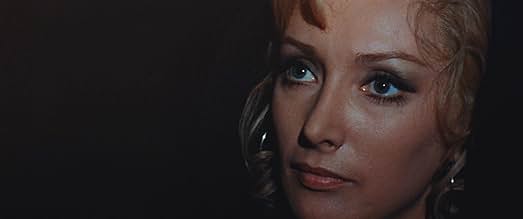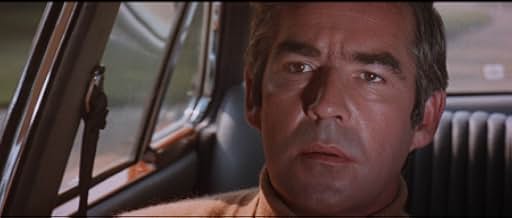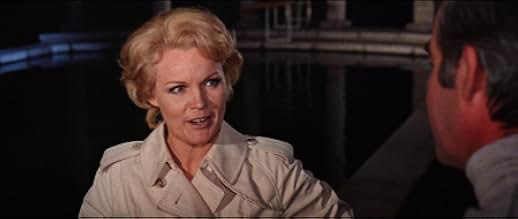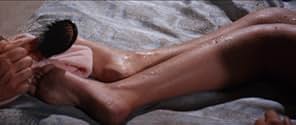AVALIAÇÃO DA IMDb
5,7/10
623
SUA AVALIAÇÃO
Adicionar um enredo no seu idiomaA wealthy Englishman finds his third wife dead. After the police discover that his first two wives had also died suddenly, an investigation is launched. Meanwhile, a new neighbor moves in an... Ler tudoA wealthy Englishman finds his third wife dead. After the police discover that his first two wives had also died suddenly, an investigation is launched. Meanwhile, a new neighbor moves in and becomes very interested in Arthur.A wealthy Englishman finds his third wife dead. After the police discover that his first two wives had also died suddenly, an investigation is launched. Meanwhile, a new neighbor moves in and becomes very interested in Arthur.
- Direção
- Roteiristas
- Artistas
- Prêmios
- 1 vitória no total
José Luis López Vázquez
- Inspector Dunphy
- (as José Luis Lopez Vazquez)
Lone Fleming
- Mrs. Wood
- (as Lone Ferck)
Maria Gustafsson
- Julies sister
- (não creditado)
Victor Harrington
- Member of Anderson's Defence Team
- (não creditado)
George Hilsdon
- Policeman in Court
- (não creditado)
Guy Standeven
- Barrister
- (não creditado)
John Tatham
- Juror
- (não creditado)
Avaliações em destaque
This international thriller with influences from America, England, Italy and Spain is sometimes called a giallo but I would say it's just a murder mystery thriller from the 70s. There's no serial killer sneaking around with black gloves, nudity is non-existent, gore is similarly off the table, and for the majority of the film it plays out like a British soap opera with a continental sense of style. Giallo-like twists do occur near the end.
I think this is one of the more coherent and easily watchable films from the era, even for people who are not completists nor super fans of gialli. The atmosphere isn't terribly creepy nor is it especially fashionable but it is rather lovely and has the requisite big houses with gold curtains.
I think this is one of the more coherent and easily watchable films from the era, even for people who are not completists nor super fans of gialli. The atmosphere isn't terribly creepy nor is it especially fashionable but it is rather lovely and has the requisite big houses with gold curtains.
The plot becomes too convoluted during the second half, but the first 30 minutes or so forms an excellent mystery focused on Mr. Anderson's unlucky marriages to 3 women all of whom died in 'accidents' within a year after their weddings.
One of the writers was Santiago Moncada, who wrote stories and scripts for some 60 Spanish/Italian productions including the excellent neo/post/whatever noir thriller 'Corruption of Chris Miller' from about the same time as 'Fourth Victim'.
The mood is set by one of the best opening sequences I've seen in a giallo-esque picture, accompanied by Piero Umiliani's languid, dreamy theme featuring those theremin-like female vocals common to Italian 70's thrillers, ooohhh-ing over a dreamy gentle but melancholy descending melody.
We see a handsome middle aged man looking through a large window on a sunny day at a beautiful blonde woman floating alone in the backyard pool, reclining on a clear plastic inflatable chair. She looks very relaxed, slumped to one side, maybe asleep under her sunglasses, a drained cocktail glass at poolside. The dreamy sad music continues.
Then we see that the cigarette in her limp hand has burned all the way down to her fingers, but she doesn't react to the burning ashes at all. Something is wrong with her.
The sad music sound fearful and menacing as it hits an ominous chord.
The burning cig has begun to melt the arm of the plastic chair, and it gradually sinks as the inert comatose woman slowly rolls over into the water and lies floating face down. The man watching her runs down some stairs through a big mansion and out to the pool, where the woman is obviously dead....
The movie should've continued with the 'dead wives' mystery, but it goes off on a silly tangent. Nevertheless, it has a unique flavor different from most giallos, which makes it recommended.
One of the writers was Santiago Moncada, who wrote stories and scripts for some 60 Spanish/Italian productions including the excellent neo/post/whatever noir thriller 'Corruption of Chris Miller' from about the same time as 'Fourth Victim'.
The mood is set by one of the best opening sequences I've seen in a giallo-esque picture, accompanied by Piero Umiliani's languid, dreamy theme featuring those theremin-like female vocals common to Italian 70's thrillers, ooohhh-ing over a dreamy gentle but melancholy descending melody.
We see a handsome middle aged man looking through a large window on a sunny day at a beautiful blonde woman floating alone in the backyard pool, reclining on a clear plastic inflatable chair. She looks very relaxed, slumped to one side, maybe asleep under her sunglasses, a drained cocktail glass at poolside. The dreamy sad music continues.
Then we see that the cigarette in her limp hand has burned all the way down to her fingers, but she doesn't react to the burning ashes at all. Something is wrong with her.
The sad music sound fearful and menacing as it hits an ominous chord.
The burning cig has begun to melt the arm of the plastic chair, and it gradually sinks as the inert comatose woman slowly rolls over into the water and lies floating face down. The man watching her runs down some stairs through a big mansion and out to the pool, where the woman is obviously dead....
The movie should've continued with the 'dead wives' mystery, but it goes off on a silly tangent. Nevertheless, it has a unique flavor different from most giallos, which makes it recommended.
A wealthy man keeps finding his wives dead under mysterious circumstances and, after standing trial and getting off, a mysterious woman enters his life and strange things start to happen.
For a giallo, The Fourth Victim is low on violence and sleaze, but the performances are better than average and the script won't make you cringe as much as many similar films. There are enough twists and turns to keep you interested without having to slice up bodies every 10 minutes. Some of the twists are silly, but silliness is to be expected with this sort of Italian thriller.
For a giallo, The Fourth Victim is low on violence and sleaze, but the performances are better than average and the script won't make you cringe as much as many similar films. There are enough twists and turns to keep you interested without having to slice up bodies every 10 minutes. Some of the twists are silly, but silliness is to be expected with this sort of Italian thriller.
A decent Giallo in which our starring becomes involved in a dangerous game of sex, lies, blackmail, treason, double-crossing and death by tacky 70s home decor. A wealthy Englishman (Michael Craig) finds his third wife dead. After the police discover that his first two wives had also died suddenly, an investigation run by an obstinete inspector (José Luís López Vazquez) is launched. Meanwhile, a new neighbor (Carroll Baker) moves in and becomes very interested in Arthur. Then Arthur Anderson finds out that his new wife just left the asylum where she was confined for years. Who could it be behind the murder?.
The fact that we know in advance what has happened does not diminish the intrigue of the story in any way. The viewer knew who the allegedly murderer was, and the plot revolved around the investigation of the colorful detective played by José Luís López Vazquez in a somewhat comical tone that does not fit the mystery of the film , and the "mistakes" that the suspect could make by giving himself away. Revolving around the supposedly guilty homicidal man and guess who the real murderer is until an incredible and surprising plot twist that is the best part of the movie. Stars the British handsome Michael Craig, along with the American star Carrol Baker, both have a long cinematic career. The latter Carroll Baker , had a small part in Easy to Love (1953), did TV commercials, and had a bit part on Broadway. She studied at the Actors Studio and was married to director Jack Garfein (one daughter, Blanche Baker). Warner Brothers, sensing a future Marilyn Monroe, cast her in Giant (1956), Baby Doll (1956) (Oscar nomination for her thumb-sucking role), The Carpetbaggers (1964) and Harlow (1965) (title role). Moving to Italy, she made films there and in England, Germany, Mexico and Spain .This American actress won a great triumph with Baby Doll (1956), after she did some Westerns. Being historically or aesthetically significant her performances : Giant (1956) and John Ford's How the West was won and Cheyenne Autumn . Signed a contract with Paramount Studios in 1963. She was given roles originally slated for Paramount starlet Stella Stevens - Harlow , The Carpetbaggers and Sylvia . The studio felt Baker was a more experienced dramatic actress and just as alluring. Then , Carroll was to Italy where she performed a lot of Giallos and softcore films , such as : "L'harem , The sweet body of Deborah , The flower with the deadly sting, Orgasm , Paranoia, The Devil with Seven Faces, Knife of Ice, Death at the Deep , End of the Swimming Pool , Il Corpo, The Private Lesson, The Virgin Wife" .Being a typical coproduction, the film is full of Spanish secondary actors: José Luis López Vázquez Alberto Fernández, Manuel Gallardo, Lone Flening (director's wife) and Italians as Marina Malfatti, Enzo Garinei .
The film stands out for its luxurious and atmospheric photography by cameraman Guglielmo Mancori shot on location in enjoyable English outdoors and in an evocative mansion where the 'Dracula' movies produced by Hammer Films were usually shot. As well as the attractive musical score by Piero Umiliani. The motion picture was professionally directed by Eugenio Martin. Craftsman Martin had the opportunity to direct films using international casts and crew which familiarized him with many different players in 1960s cinema, by many accounts among the most fertile and creative periods in film history. In his starts Martín made a series of well-regarded short films and documentaries before making his first feature film Despedida de soltero ("Farewell to the Single Life"), in 1957. In 1966 Martín directed The Bounty Killer (released as The Ugly Ones in the United States), the first of many Westerns he was to create, it remains among his better known works . Martín's next three films were domestic musicals, one of which starred crooner Julio Iglesias. He began frequently using Spain as an affordable site for location shooting, Martín took advantage of opportunities for collaboration and worked with a number of foreign directors, most notably Nicholas Ray. He was known for the low-middle budget genre films he made in the 1960s and 1970s, including Bad Man's River, The Bounty Killer, and Horror Express, the latter being particularly notable for its inclusion of the well-known English actors Christopher Lee and Peter Cushing, famous for their work with Hammer Films. Though never remarkably successful either at the box office or among critics, Martín's films, particularly Horror Express, have achieved cult status. Eugenio Martin and won prizes conceded by Spanish Spectacle Syndicate. Martin is a horror-mystery movies expert ( Horror express, Hypnosis, A candle for the devil , The fourth Mrs Anderson ) and Spaghetti Western ( Requiem, for a gringo , Pancho Villa , The ugly ones , Bad man's river ). Martín made several musicals and giallo-type films in the 70's, solidifying his reputation as "an auteur in every genre", per the subtitle of a recent biography. Rating La última señora Anderson(1971) : 6/10.
The fact that we know in advance what has happened does not diminish the intrigue of the story in any way. The viewer knew who the allegedly murderer was, and the plot revolved around the investigation of the colorful detective played by José Luís López Vazquez in a somewhat comical tone that does not fit the mystery of the film , and the "mistakes" that the suspect could make by giving himself away. Revolving around the supposedly guilty homicidal man and guess who the real murderer is until an incredible and surprising plot twist that is the best part of the movie. Stars the British handsome Michael Craig, along with the American star Carrol Baker, both have a long cinematic career. The latter Carroll Baker , had a small part in Easy to Love (1953), did TV commercials, and had a bit part on Broadway. She studied at the Actors Studio and was married to director Jack Garfein (one daughter, Blanche Baker). Warner Brothers, sensing a future Marilyn Monroe, cast her in Giant (1956), Baby Doll (1956) (Oscar nomination for her thumb-sucking role), The Carpetbaggers (1964) and Harlow (1965) (title role). Moving to Italy, she made films there and in England, Germany, Mexico and Spain .This American actress won a great triumph with Baby Doll (1956), after she did some Westerns. Being historically or aesthetically significant her performances : Giant (1956) and John Ford's How the West was won and Cheyenne Autumn . Signed a contract with Paramount Studios in 1963. She was given roles originally slated for Paramount starlet Stella Stevens - Harlow , The Carpetbaggers and Sylvia . The studio felt Baker was a more experienced dramatic actress and just as alluring. Then , Carroll was to Italy where she performed a lot of Giallos and softcore films , such as : "L'harem , The sweet body of Deborah , The flower with the deadly sting, Orgasm , Paranoia, The Devil with Seven Faces, Knife of Ice, Death at the Deep , End of the Swimming Pool , Il Corpo, The Private Lesson, The Virgin Wife" .Being a typical coproduction, the film is full of Spanish secondary actors: José Luis López Vázquez Alberto Fernández, Manuel Gallardo, Lone Flening (director's wife) and Italians as Marina Malfatti, Enzo Garinei .
The film stands out for its luxurious and atmospheric photography by cameraman Guglielmo Mancori shot on location in enjoyable English outdoors and in an evocative mansion where the 'Dracula' movies produced by Hammer Films were usually shot. As well as the attractive musical score by Piero Umiliani. The motion picture was professionally directed by Eugenio Martin. Craftsman Martin had the opportunity to direct films using international casts and crew which familiarized him with many different players in 1960s cinema, by many accounts among the most fertile and creative periods in film history. In his starts Martín made a series of well-regarded short films and documentaries before making his first feature film Despedida de soltero ("Farewell to the Single Life"), in 1957. In 1966 Martín directed The Bounty Killer (released as The Ugly Ones in the United States), the first of many Westerns he was to create, it remains among his better known works . Martín's next three films were domestic musicals, one of which starred crooner Julio Iglesias. He began frequently using Spain as an affordable site for location shooting, Martín took advantage of opportunities for collaboration and worked with a number of foreign directors, most notably Nicholas Ray. He was known for the low-middle budget genre films he made in the 1960s and 1970s, including Bad Man's River, The Bounty Killer, and Horror Express, the latter being particularly notable for its inclusion of the well-known English actors Christopher Lee and Peter Cushing, famous for their work with Hammer Films. Though never remarkably successful either at the box office or among critics, Martín's films, particularly Horror Express, have achieved cult status. Eugenio Martin and won prizes conceded by Spanish Spectacle Syndicate. Martin is a horror-mystery movies expert ( Horror express, Hypnosis, A candle for the devil , The fourth Mrs Anderson ) and Spaghetti Western ( Requiem, for a gringo , Pancho Villa , The ugly ones , Bad man's river ). Martín made several musicals and giallo-type films in the 70's, solidifying his reputation as "an auteur in every genre", per the subtitle of a recent biography. Rating La última señora Anderson(1971) : 6/10.
This is quite a stylish production with a fine cast and a good ending. However, it is rather slow which may cause some viewers to lose interest half way through the film. This is definitely worth seeing if you are a fan of obscure giallo's or Spanish Horror/Exploitation (like me!), otherwise it's probably not worth tracking down. (For those interested, there is only one video release of this that anybody has been able to find, which was on "Master Home Video" in Greece. It was fully uncut, but is long deleted as it was released sometime between 1984 and 1987. The cover art is very cool and totally misleading!)
Você sabia?
- CuriosidadesArthur drives a light blue Jaguar.
- Citações
Arthur Anderson: [of Julie] Where the hell is she?
- ConexõesReferenced in O Quarto Homem (1983)
Principais escolhas
Faça login para avaliar e ver a lista de recomendações personalizadas
- How long is The Fourth Victim?Fornecido pela Alexa
Detalhes
Contribua para esta página
Sugerir uma alteração ou adicionar conteúdo ausente































